|
|
|
|
Politics
|
|
Locals
Expect Base Closings to Bypass Andrews
By Ryan Basen TEMPLE HILLS, Md. - As a few people quietly dined inside a dimly lit Regina Pizzeria, Dario Caccibillani took a break from tossing dough, serving customers and chatting with employees to pose a serious question. "Are they going to close Andrews?" he wondered. Caccibillani, who owns Regina, was referring to Andrews Air Force Base, the huge military base just a few blocks down Allentown Road. "They" are federal government officials, who are scheduled this month to release a list of military installations targeted for consolidation or closure under the Base Realignment and Closure process. While as many as one-fifth of the nation's bases could close in the latest round of BRAC, no one with knowledge of Andrews, including residents of Suitland, Clinton and other nearby Prince George's County towns, believe the air base will be among them. More than likely, officials said, the 6,800-acre base will benefit from this round of BRAC, the first since 1995. But the fear of change resonates among those whose well-being is so dependent on Andrews being open and thriving. "Andrews is a tremendous asset to the county," said Jim Estepp, a former Prince George's County Council member and resident for more than 50 years. "Anything that would happen to the base would have a tremendous impact on the community." Andrews opened in a flat area 10 miles southeast of the District in 1943 and has grown into one of the largest, most recognizable bases in the United States. The primary mission of its "host wing," the 89th Airlift Wing, is to transport U.S. presidents, world leaders, war heroes and other dignitaries. It has a tradition of professionalism and perfectionism known as SAM Fox, the call sign for Special Air Mission-Foreign. The Naval Air Facility and numerous federal offices are also located at Andrews. Today, thousands of people work and live on the base, which is surrounded by a community trying to keep pace in a rapidly growing metro area. The average median household income in communities around Andrews is about $44,000, according to Sperling's Best Places, which analyzes local data. While higher than the national average of $38,353, it is far below the Washington-area average of $65,345. The community also has higher unemployment (4 percent versus 2.8 percent) and lower job growth (3 percent to 3.6 percent) than the metro-area average. With that below-average economic situation, southwestern Prince George's County needs Andrews. The base employs about 16,000 people, including 6,000 civilians, according to The Sam Fox Story, a publication for members of the 89th Airlift Wing. On a recent afternoon, a posted list at the base visitor's center indicated that Andrews was hiring several more civilian employees, including mechanics, child care workers, janitors, waiters and employees to work on one of three golf courses. About 20,000 people live on the base and many ingratiate themselves in the community. Andrews is responsible for pumping $1.2 billion directly into the county's economy, and another $5 billion or 6 billion indirectly, according to the Andrews Alliance, a coalition established to lobby for and support Andrews. Wendi M. Williams, president of the Prince George's Chamber of Commerce for five years until March, said the local economy is fueled by base employment of civilians and its military personnel's spending habits. Andrews officials and employees also help in the community. They have donated more than 30,000 books over the last two years, volunteer to read to and tutor schoolchildren and even set up a computer network at one local school. "They are a vital part of the community both economically and socially," said Estepp, president of the Andrews Alliance. Caccibillani estimates that 90 percent of his business is Andrews-related. He took a major hit when deliveries were forbidden to Andrews after the attacks of Sept. 11, 2001. "All of the business here is Andrews," he said. "When they change it affects us." Douglas Shifflett, a manager at S/W Liquors nearby, said Andrews personnel visit the store, owned by his father, every day. If Andrews closed "business would still go on," he said. But "I know it would affect the area here." A manager at Allentown Liquors said his store also does a lot of business with Andrews personnel and takes pride in having the base nearby. "If they did not have the base here," said the manager, who refused to give his name, "the area would be dead." Local merchants should not fret, officials said. The federal government may consolidate resources or make other changes at Andrews, but they won't close the base. Andrews officials are, in fact, expanding their command post and establishing an Operations Center with one point of contact, Brigadier Gen. David S. Gray told the base publication Sam Fox. They are also hiring more contractors for jobs formerly handled by military personnel. "We don't anticipate that Andrews is going to lose anything," Estepp said, noting that BRAC officials will take community impact into consideration. "We think if anything would happen, it would gain." Andrews will not close and any changes made there will not negatively affect local businesses, said Mike Hayes, director of the office of military affairs for the state Department of Business and Economic Development. "Andrews," Hayes said, comparing it to Maryland's other 10 large military bases, "is probably among the least of our concerns."
Copyright ©
2005 University of
Maryland Philip Merrill College of Journalism
|


